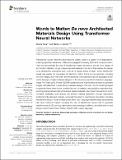| dc.contributor.author | Yang, Zhenze | |
| dc.contributor.author | Buehler, Markus J | |
| dc.date.accessioned | 2021-11-03T16:53:24Z | |
| dc.date.available | 2021-11-03T16:53:24Z | |
| dc.date.issued | 2021-10-06 | |
| dc.identifier.uri | https://hdl.handle.net/1721.1/137240 | |
| dc.description.abstract | <jats:p>Transformer neural networks have become widely used in a variety of AI applications, enabling significant advances in Natural Language Processing (NLP) and computer vision. Here we demonstrate the use of transformer neural networks in the <jats:italic>de novo</jats:italic> design of architected materials using a unique approach based on text input that enables the design to be directed by descriptive text, such as “<jats:italic>a regular lattice of steel</jats:italic>”. Since transformer neural nets enable the conversion of data from distinct forms into one another, including text into images, such methods have the potential to be used as a natural-language-driven tool to develop complex materials designs. In this study we use the Contrastive Language-Image Pre-Training (CLIP) and VQGAN neural networks in an iterative process to generate images that reflect text prompt driven materials designs. We then use the resulting images to generate three-dimensional models that can be realized using additive manufacturing, resulting in physical samples of these text-based materials. We present several such word-to-matter examples, and analyze 3D printed material specimen through associated additional finite element analysis, especially focused on mechanical properties including mechanism design. As an emerging new field, such language-based design approaches can have profound impact, including the use of transformer neural nets to generate machine code for 3D printing, optimization of processing conditions, and other end-to-end design environments that intersect directly with human language.</jats:p> | en_US |
| dc.language.iso | en | |
| dc.publisher | Frontiers Media SA | en_US |
| dc.relation.isversionof | 10.3389/fmats.2021.740754 | en_US |
| dc.rights | Creative Commons Attribution 4.0 International license | en_US |
| dc.rights.uri | https://creativecommons.org/licenses/by/4.0/ | en_US |
| dc.source | Frontiers | en_US |
| dc.title | Words to Matter: De novo Architected Materials Design Using Transformer Neural Networks | en_US |
| dc.type | Article | en_US |
| dc.identifier.citation | Yang, Zhenze and Buehler, Markus J. 2021. "Words to Matter: De novo Architected Materials Design Using Transformer Neural Networks." Frontiers in Materials, 8. | |
| dc.contributor.department | Massachusetts Institute of Technology. Laboratory for Atomistic and Molecular Mechanics | |
| dc.contributor.department | Massachusetts Institute of Technology. Department of Civil and Environmental Engineering | |
| dc.contributor.department | Massachusetts Institute of Technology. Department of Materials Science and Engineering | |
| dc.contributor.department | Massachusetts Institute of Technology. Center for Computational Science and Engineering | |
| dc.relation.journal | Frontiers in Materials | en_US |
| dc.eprint.version | Final published version | en_US |
| dc.type.uri | http://purl.org/eprint/type/JournalArticle | en_US |
| eprint.status | http://purl.org/eprint/status/PeerReviewed | en_US |
| dc.date.updated | 2021-11-03T16:50:15Z | |
| dspace.orderedauthors | Yang, Z; Buehler, MJ | en_US |
| dspace.date.submission | 2021-11-03T16:50:17Z | |
| mit.journal.volume | 8 | en_US |
| mit.license | PUBLISHER_CC | |
| mit.metadata.status | Authority Work and Publication Information Needed | en_US |
